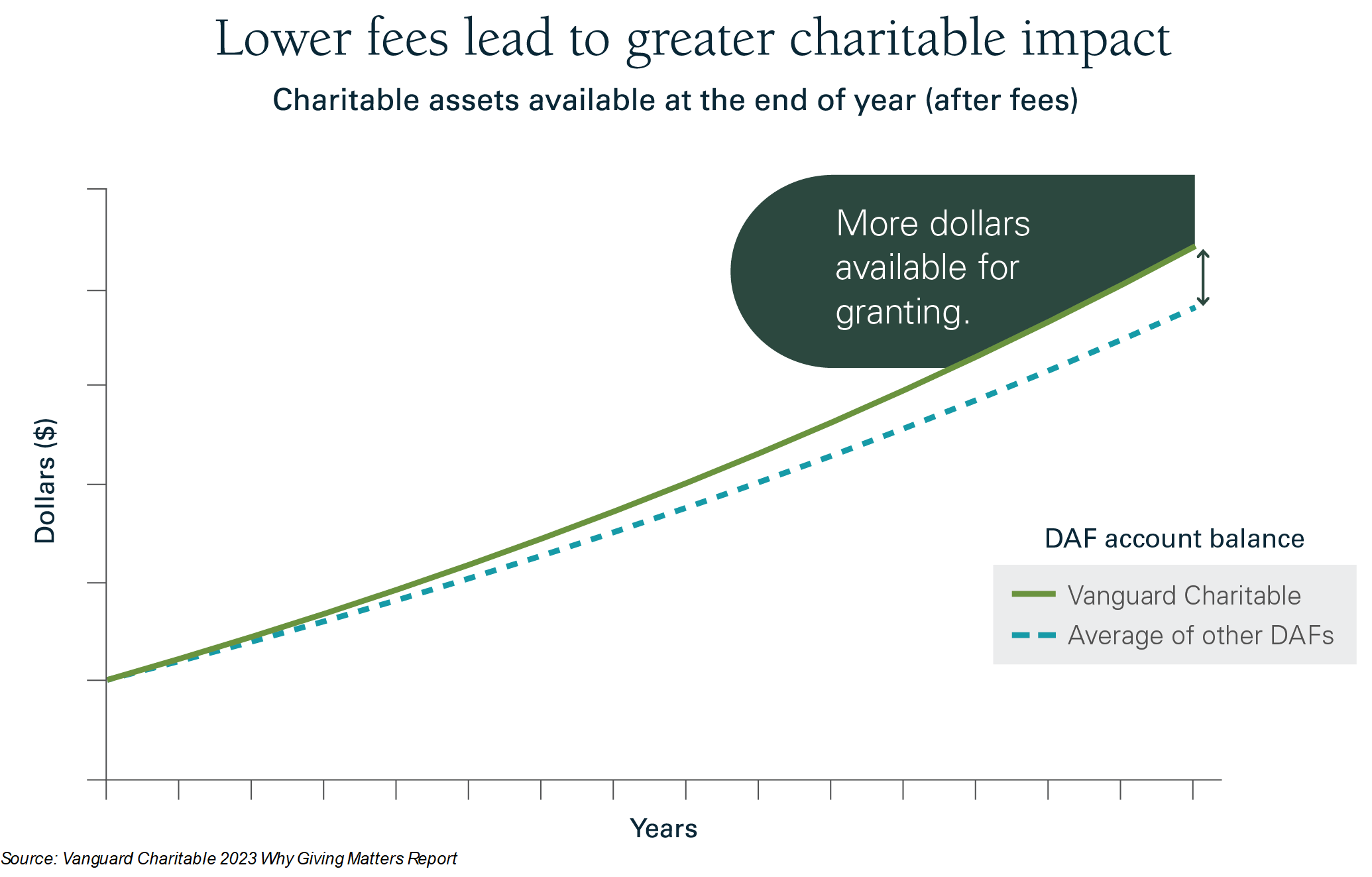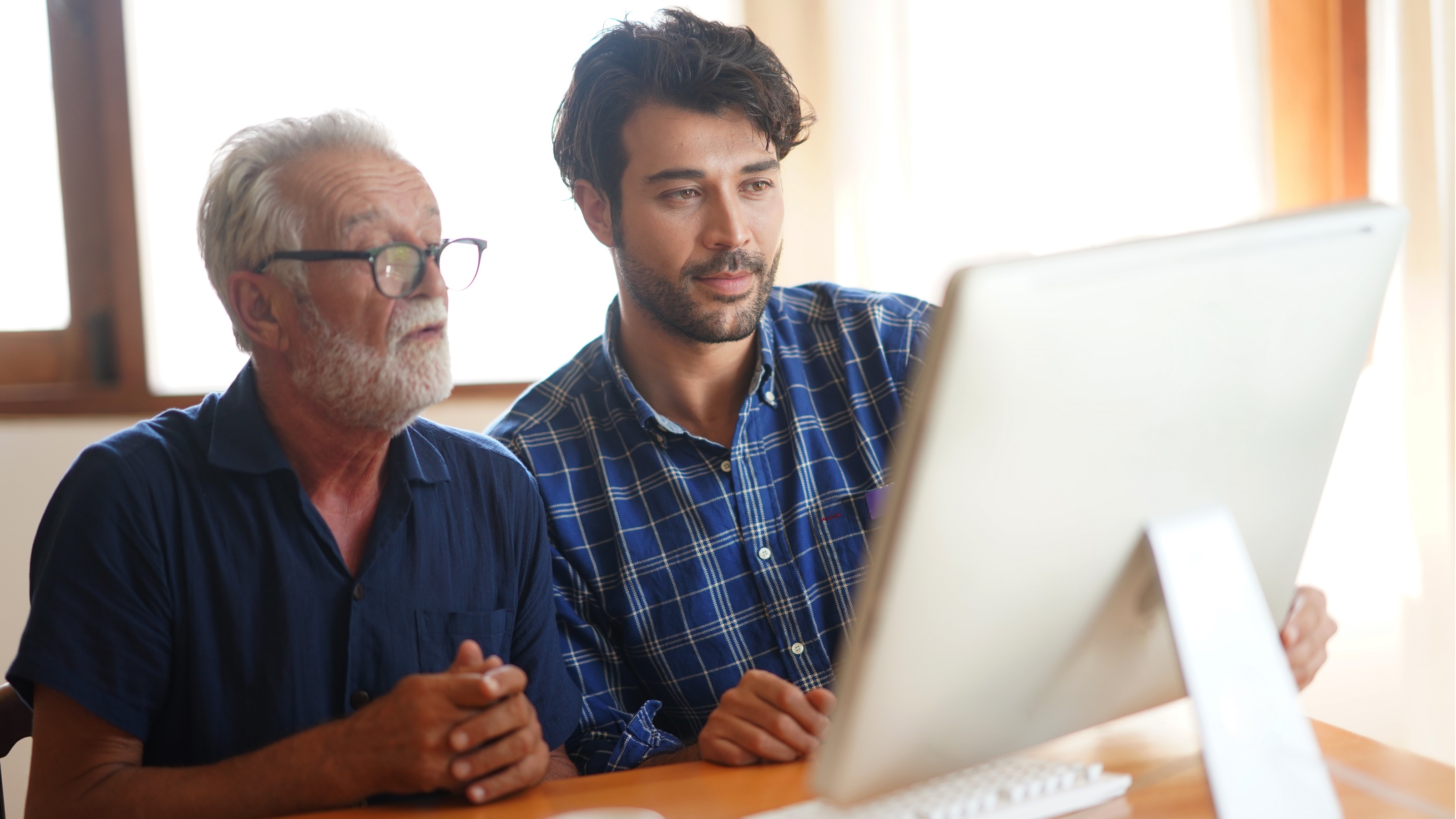The Secret to Supercharging Your Charitable Giving: Low Fees
What are you paying in investment and administrative fees? The less you pay, the more your money grows, and so does the impact your giving makes.


Charitable giving vehicles can be powerful tools in maximizing philanthropic impact. Private foundations, charitable trusts and donor-advised funds (DAFs) all allow donors to invest charitable assets for growth, expand the assets they can give to charity, and help with due diligence around selecting causes and organizations to support. This kind of strategic support requires oversight and administration — both of which carry a cost.
Many factors influence your ability to earn a return. That’s true across all kinds of investing, including charitable investing, where "return" equates to "charitable impact" for the causes philanthropically minded investors care about. While we can't control markets or the economy, we can control the costs we pay in managing or allocating our charitable dollars.
Ultimately, investment data is clear: The expense ratio is the most proven predictor of future fund returns. Money paid in fees ultimately comes out of the sum of assets, which means there is less to invest, grow and use for grantmaking.

Sign up for Kiplinger’s Free E-Newsletters
Profit and prosper with the best of expert advice on investing, taxes, retirement, personal finance and more - straight to your e-mail.
Profit and prosper with the best of expert advice - straight to your e-mail.
Understanding the nature of fees and costs and their impact on an individual’s ability to give is an essential component of an effective charitable giving strategy. That strategy starts with a deeper dive into the fees and how they differ across giving vehicles. When evaluating costs and fees in philanthropic giving, particularly in the context of private foundations and donor-advised funds (DAFs), here are a few key points to keep in mind.
Most charitable giving costs fall into two categories
Most of the costs associated with investing — whether it be for charitable giving, retirement or other purposes — come from one of two sources: investment fees and administrative fees.
Investment fees cover the costs of managing invested assets. Different asset classes will have different fees and overall costs, and different investment vehicles and advisers will as well.
Administrative fees cover general operating costs, including legal, accounting, processing and staffing expenses. These administrative fees can also vary greatly depending on the organization or individual overseeing the philanthropic strategy. Costs related to operations, and tools such as investor services, investment portals and research, may be included under administrative fees.
Different approaches come with different costs
The complexity and focus of the charitable investment vehicle can be a driving force in cost structure and overall fees. A private foundation can include services and approaches highly tailored to a family or donor’s specific needs. Naturally, those high-touch services can increase administrative fees. At the same time, advisers and other oversight or guidance can also drive up investment fees.
DAFs, a giving vehicle that can support a wide array of causes through grants to qualified 501(c)(3) charities, tend to prioritize a low-cost, high-impact approach to philanthropy. DAFs benefit from economies of scale around operations and grantmaking, with annual administrative fees among national DAF sponsors typically falling around 0.6%, and investment fees ranging from 0.015% to 0.99%. Community foundations may charge more for DAFs but may also offer useful philanthropic and granting guidance relevant to the communities they serve.
Certain DAF sponsors, including Vanguard Charitable, utilize additional levers to maintain low costs. These can include curating a smaller number of high-performing investment options, as well as giving donors access to low-cost share classes typically unavailable to the public.
There’s also a broader philosophical perspective around fees and costs worth exploring across giving vehicles. Some organizations align their entire approach around keeping costs low. At Vanguard Charitable, for instance, recent reductions in the expense ratios for several of its 35 investment options will lead to annual savings of more than $1 million, which will be granted by Vanguard Charitable donors to hardworking charities across the country and the world.
Savings — and tax benefits — compound over time

Investors like to call compound growth “the eighth wonder of the world.” And for good reason. Just like saving for retirement or any other investment approach, the positive effect of lower fees has a greater impact over time. These compound benefits play out on a few key fronts. Lower investment and administrative fees mean a greater portion of assets can be directed toward charitable investments. This, in turn, means more dollars are available to grant to nonprofits, deliver on a philanthropic strategy, and make an impact on meaningful cause areas.
The compound benefits extend to tax savings, too. The upfront tax savings for charitable contributions means more dollars are available to potentially grow and grant out over time. At the same time, the tax-free earnings for assets in an account compound over time, again allowing more money to be directed toward charitable giving. These tax savings can be achieved with both DAFs and private foundations, although private foundations are subject to a separate excise tax on net investment income, whereas DAFs are not.
Meaningful conversations around costs and charitable giving
Strategic charitable giving can seem complex. At the end of the day, the approach to costs is simple: Lower fees mean more money can be made available for the charities you care about.
Considerations around costs and fees are vital for charitable giving planning. Individuals and families looking to extend their philanthropic mission should explore these details, seeking out partners who are transparent about their fee structures and committed to keeping costs low. Ultimately, that commitment will allow donors to do more with their charitable dollars to continue supporting the causes that matter most to them — now and well into the future.
Related Content
Get Kiplinger Today newsletter — free
Profit and prosper with the best of Kiplinger's advice on investing, taxes, retirement, personal finance and much more. Delivered daily. Enter your email in the box and click Sign Me Up.

Mark Froehlich joined Vanguard Charitable, a 501(c)(3) public charity sponsoring donor-advised funds, as chief financial officer in 2019. As a certified public accountant, he works to oversee the nonprofit’s finance and operations functions. An experienced financial leader, Mark has always maintained a strong connection to the nonprofit sphere. Most recently, he was the chief financial officer at the Philadelphia Foundation.
-
 Easing the Challenges of Caring for Aging Parents
Easing the Challenges of Caring for Aging ParentsHere are some strategies that can help reduce the effort and stress involved.
By Mario Hernandez
-
 How to Access Private Markets with Interval Funds
How to Access Private Markets with Interval FundsLet's explore how interval funds work — and how they're opening the doors to private market investing.
By Nicholas Pope
-
 Bouncing Back: New Tunes for Millennials Trying to Make It
Bouncing Back: New Tunes for Millennials Trying to Make ItAdele's mournful melodies kick off this generation's financial playlist, but with the right plan, Millennials can finish strong.
By Alvina Lo
-
 Early-Stage Startup Deals: How Do Convertible Notes Work?
Early-Stage Startup Deals: How Do Convertible Notes Work?Some angel investors support early startups by providing a loan in exchange for a convertible note, which includes annual interest and a maturity date.
By Murat Abdrakhmanov
-
 SRI Redefined: Going Beyond Socially Responsible Investing
SRI Redefined: Going Beyond Socially Responsible InvestingNow that climate change has progressed to a changed climate, sustainable investing needs to evolve to address new demands of resilience and innovation.
By Peter Krull, CSRIC®
-
 Here's When a Lack of Credit Card Debt Can Cause You Problems
Here's When a Lack of Credit Card Debt Can Cause You ProblemsUsually, getting a new credit card can be difficult if you have too much card debt, but this bank customer ran into an issue because he had no debt at all.
By H. Dennis Beaver, Esq.
-
 Going to College? How to Navigate the Financial Planning
Going to College? How to Navigate the Financial PlanningCollege decisions this year seem even more complex than usual, including determining whether a school is a 'financial fit.' Here's how to find your way.
By Chris Ebeling
-
 Financial Steps After a Loved One's Alzheimer's Diagnosis
Financial Steps After a Loved One's Alzheimer's DiagnosisIt's important to move fast on legal safeguards, estate planning and more while your loved one still has the capacity to make decisions.
By Thomas C. West, CLU®, ChFC®, AIF®
-
 How Soon Can You Walk Away After Selling Your Business?
How Soon Can You Walk Away After Selling Your Business?You may earn more money from the sale of your business if you stay to help with the transition to new management. The question is, do you need to?
By Evan T. Beach, CFP®, AWMA®
-
 Two Don'ts and Four Dos During Trump's Trade War
Two Don'ts and Four Dos During Trump's Trade WarThe financial rules have changed now that tariffs have disrupted the markets and created economic uncertainty. What can you do? (And what shouldn't you do?)
By Maggie Kulyk, CRPC®, CSRIC™